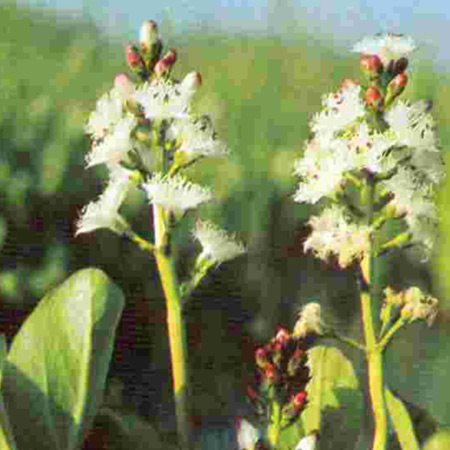Botanical name
Menyanthes trifoliata L.
Family
Menyanthaceae
Common name
Bogbean, Buckbean. Bitter clover, Fever clover
Information about the plant
The bogbean grows in the Circumpolar region and is widespread in the temperate zones of the Northern Hemisphere, from northern Europe to Iceland. It grows very densely in swamps, ponds, on silted lake shores or slow-flowing waters, as well as in fens and bogs, and owes its name to its clover-like, tripartited leaves and bitter taste. A small piece placed on the tongue quickly reveals this. The bitter taste has also earned the plant the name "fever clover" in reference to the antipyretic effect of bitter cinchona bark, which was previously used to treat fever, and is used as such in folk medicine in north-eastern Europe. The clover-like, tripartite leaves are reflected in the species epithet trifoliata (= trifoliate). It is unclear where the genus name Menyanthes derives from, but the second part certainly comes from the Greek 'anthos' (= flower).
The bogbean grows up to 30 cm high, and has a long creeping rhizome, which then turns into an upright stem. The leaves are alternate, tripartite, with a 7 to 20 cm long stalk, the individual leaflets are ovate with entire margins, somewhat fleshy and up to 10 cm long. 10 to 20 small, pale blue to pink flowers form a conical raceme.
The petals are folded back to the middle so that their fringed inner side is clearly visible. The seeds are buoyant and are spread by streaming water and the plumage of waterfowl. The flowering time is from May to June.
Medicinally used parts of plants (herbal drug)
The dried leaves (Menyanthidis trifoliatae folium) are used. The commercially available drug comes from wild plant populations in Eastern European countries.
Constituents of the herbal drug
The leaves contain bitter substances of the secoiridoid type, flavonoids, phenolcarboxylic acids, and coumarins.
Quality of the drug
The quality of the leaves (Menyanthidis trifoliatae folium) is specified in the European Pharmacopoeia (Ph. Eur.).
Medical applications
Recognised medical use
The HMPC has classified bogbean leaves as a traditional herbal medicinal product (see "Traditional use")
ESCOP: as a bitter remedy in loss of appetite, atonic dyspepsia, and peptic discomfort; for gall bladder disorders.
Traditional use
Bogbean leaves have been classified by the HMPC as a traditional herbal medicinal product (Article 16a of Directive 2001/83/EC). Based on long-standing use and experience, bogbean leaves can be used to treat temporary loss of appetite and mild digestive disorders such as flatulence and bloating, as well as to relieve mild articular and muscular pain.
Herbal drug preparations in finished dosage forms
- cut leaves for tea preparation
- aqueous extracts in "herbal bitters"
Dosage
Finished medicinal products: see patient information leaflet.
Tea infusion: drink a cup of warm bogbean leaves tea several times a day. It can also be combined with other drugs such as wormwood, centaury, and yarrow flower (stomach teas). The infusion should be drunk half an hour before meals to stimulate the appetite and after meals for digestive complaints. Daily dose: 1.5 to 3 g drug.
Preparation of a tea
Pour 150 mL of boiling water over 0.5 to 1 g of finely chopped bogbean leaves, and strain after 10 to 15 minutes.
Notes
Bogbean leaves should not be taken in the case of existing stomach ulcers; no evidence is available on the use of bogbean leaves during pregnancy and lactation; use in children under 12 years of age is not recommended due to a lack of evidence.
Side effects
High doses may cause nausea, vomiting, and diarrhea.
Interactions
None known.
References
Herbal drug monographs
Further literature
Commentary on the European Pharmacopoeia (Ph.Eur. No. 1605)



